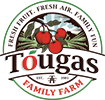
Over 30 Varieties of Pick Your Own Apples on over 40K Trees! Including HoneyCrisp™, McIntosh & EverCrisp™!
Pick your own apple season runs from the middle of August through early November, but can move by as much as 2 weeks either direction. To be sure you never miss picking your own apples, be sure to sign up for our What’s Picking Email Alerts.

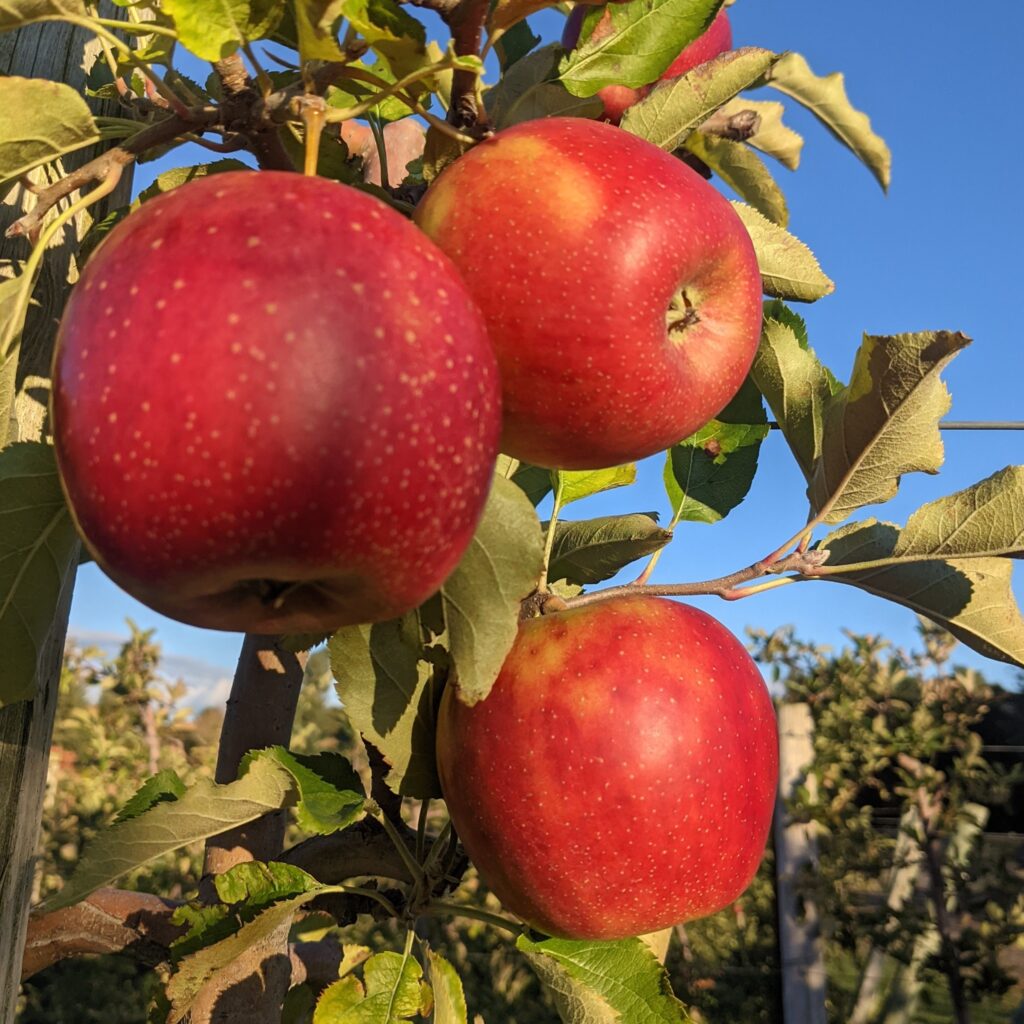
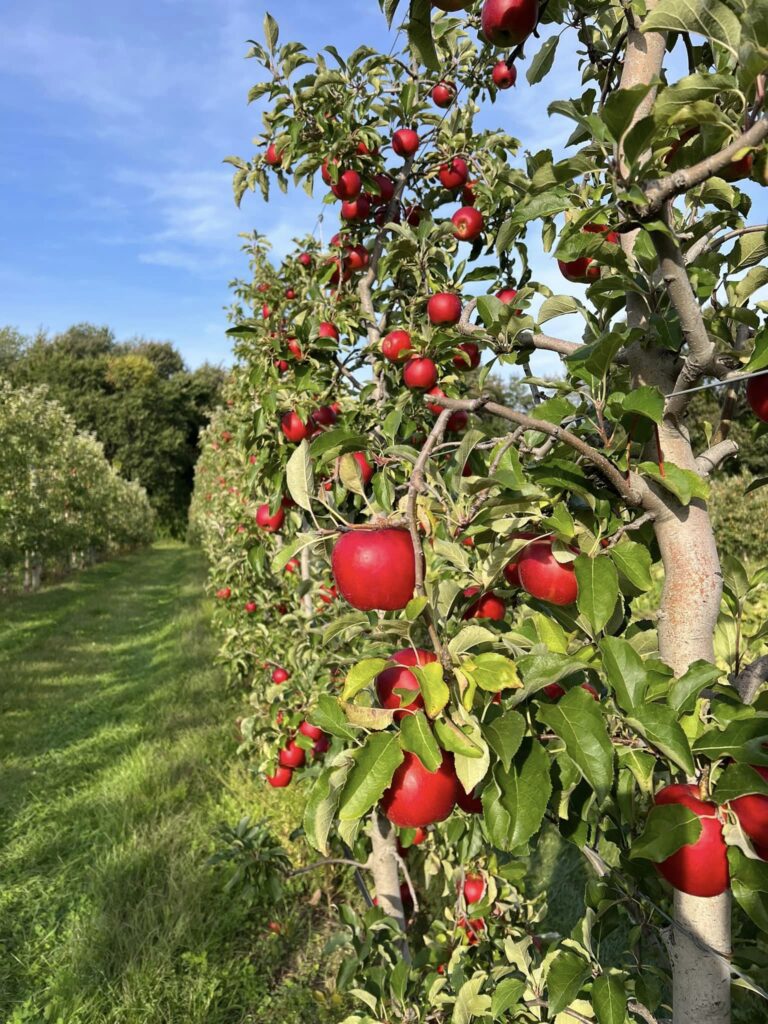
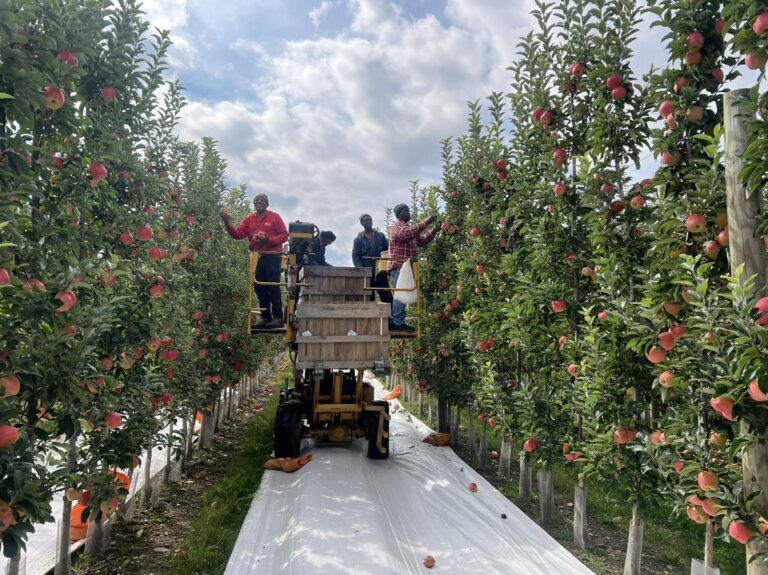
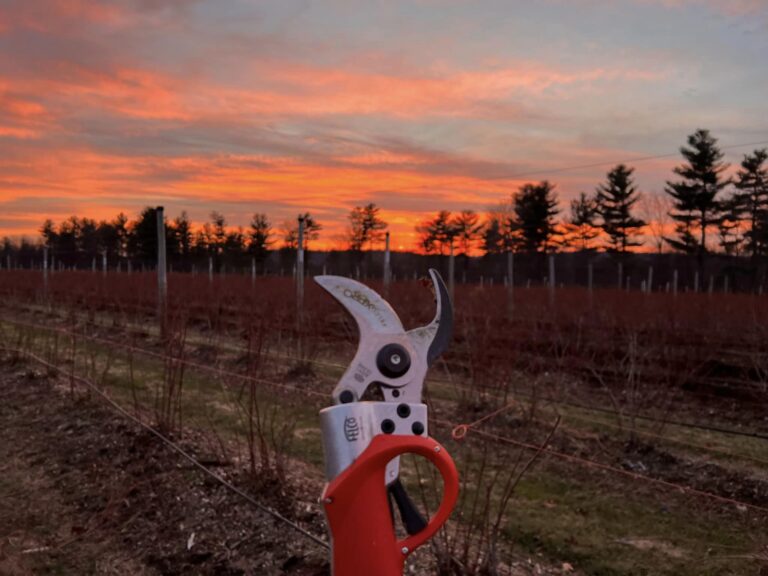
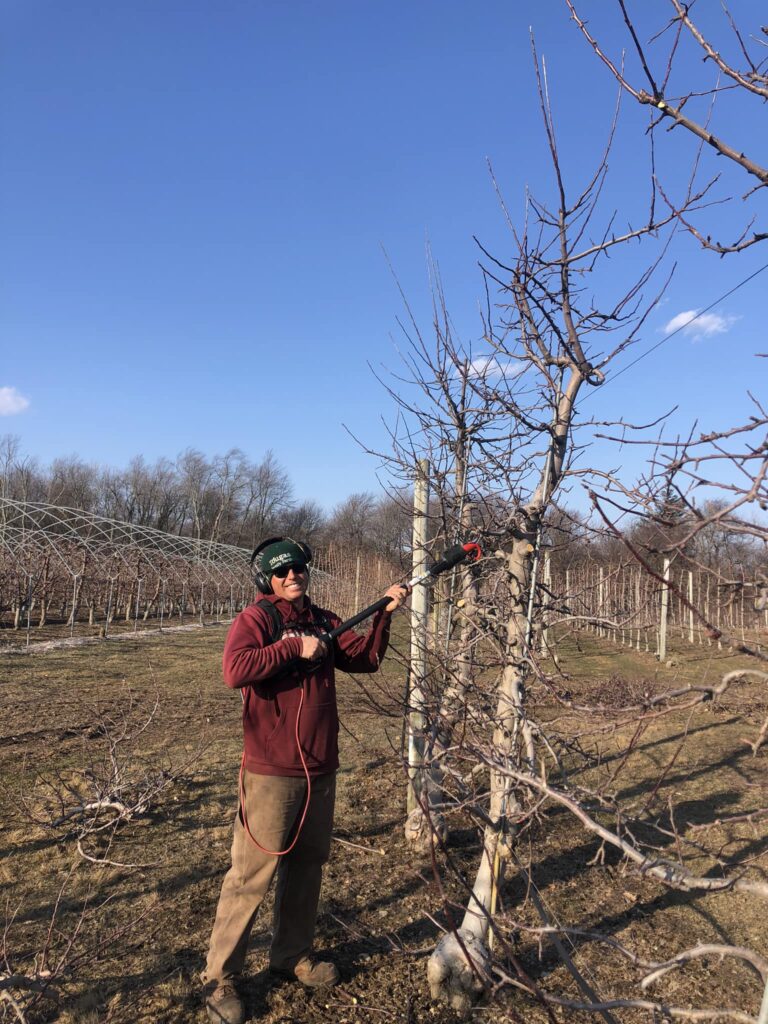
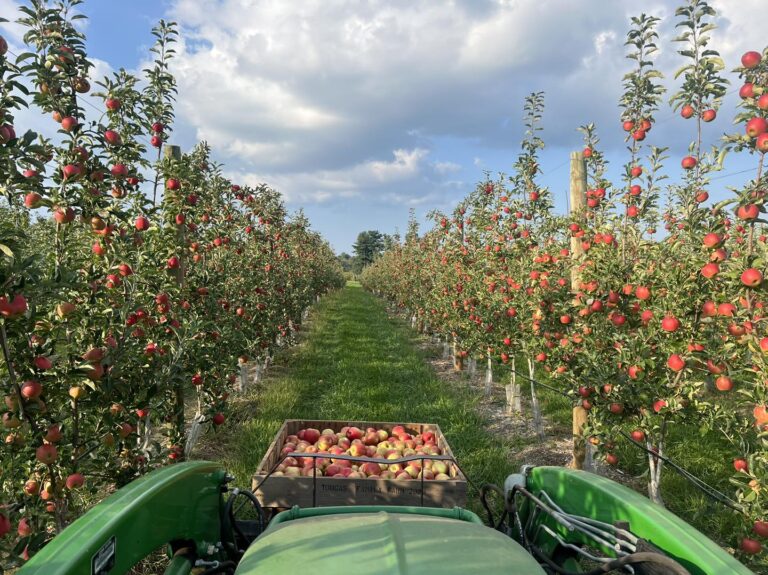
Our Pick You Own Apple Season
Our pick your own apple season here west of Boston, starts in mid-August and lasts through early November. We have so many varieties of apples, you could come and pick your own apples every month and pick a different, tasty apple!
Our PYO Apple Varieties - An Apple for Every Taste!
We grow over thirty varieties of apples that are available to pick your own. We pride ourselves on having an extensive selection of apple varieties, many of which are not found at the supermarket. Some people have a favorite apple that they come back for year after year and others like to mix their bags and surprise themselves later.
Among our specialty apples are the kicks-the-back-of-your-throat Topaz and the apple that seems to store crisp and fresh forever, EverCrisp.
How We Grow Pick Your Own Apples
Did you know it takes 3-5 years for apple trees to produce apples after planting? Our pick your own apple orchards are a long labor of love, starting with nurturing a seedling tree, then grafting it onto our root stock and carefully training and pruning it into a row.
WINTER: Every winter we hand prune all 40,000+ trees, to promote tree health, decrease pests and encourage fruit development.
SPRING: In the spring, when the apple blossoms start blooming, we purchase and rent bumble bees and honey bees to pollinate. In order to grow big, juicy apples we also must hand-thin some of the blossoms off every tree. It’s a balance! Too little blooms and the crop is thin, too many blooms the apples are small and can become diseased.
During the early season we also spread a rich compost we create on the farm, to provide organic nutrients back into the soil. After the spreading of compost we then cover with mulch, which helps to retain nutrient-rich soil and moisture where the trees need it. Mulching our rows also creates a weed and grass free row, meaning NO RoundUp, which is commonly used in orchard rows on other farms.
SUMMER: During dry growing seasons, we water over 90% of our crops from water retention ponds through our drip irrigation system. Drip irrigation slowly supplies water to the roots of our trees, drip by drip, which means very little water run off, if any, and no water evaporation into the air like traditional overhead sprinklers. All and all, we are using less water than traditional overhead sprinklers require.
We grow our fruit utilizing the Integrated Pest Management system. This means we monitor pest levels throughout the growing season by hiring scouts to manually count insect types and populations. The IPM approach means pesticides often are not even used, even when pests are present, because there are not enough of them to pose a serious threat to the crops. Overall, IPM helps to reduce the use of pesticides all-together which is the bottom-line goal of most conscientious consumers.
Fall: In August we start checking the apples daily, as varieties enter their picking window, to monitor their ripening progress. We carefully determine when picking starts and do not allow picking until we’ve reached optimal ripeness. It is important to us that everyone experiences our apples at the peak of their flavor and that we manage the picking of our orchards to reduce leftover fruit, which is both a waste and also promotes pest and disease.
Apple Goodies from our Farm Store & Kitchen Menu
🍎 PYO Apple Experience🍎
Where to go: Find parking in our large, easy and free lot. Our apple orchards are entered most often from our East Entrance, and occasionally from the West Entrance depending on where the fruit is ready for picking at the time of your visit – look for our signs directing you to the correct entrance or visit the Farm Store for directions.
How to Pay: At our Field Entrance you will purchase your PYO Field Admission. We accept cash, MC, Visa, Discover, Amex and SNAP cards.
Getting into the Field: Enjoy a walk to our beautiful orchards or take a wagon ride to the picking area. Occasionally picking fields are only accessible by foot but if you require a ride, please ask and we will do our very best to accommodate
Timing: Apple picking takes, on average 1.5 hours, depending on the age of pickers and how much fruit you are looking to pick. Make a day of it and pick some fresh-from-the-field fruit and then grab an ice cream and visit the animals.
- Wear closed-toed shoes
- Wear sunscreen
- Sunglasses and/or a hat
- Bring or Purchase water
Q. Why do you direct me to a specific section of the field?
A. Our goal is always to provide the best berries possible! One way to accomplish this goal is to have people pick out rows, one by one. That way the next person always has an abundance of berries to pick.
Q. Why do I have to ask an Harvest Guide if I want to move rows?
A. Our Harvest Guides are responsible for getting the entire field picked and keep track of what still needs to be picked. By asking where to go you enable our Guides to keep track of where needs to be picked and what is now finished for the day.
How to Pick Your Own Apples
- Park in one of our free parking lots
- Follow the apple signs to the location we are picking at the moment
- You and your group will be assigned
- LIFT AND TWIST THE APPLE – keep twisting until it falls into your hand. Do Not Pull the apple so the tree is not injured.
- Place any over ripe or damaged fruit into a provided “icky berry” bucket. When you are finished picking, give the bucket to a staff person or leave it at the composting station. This is crucial for our pest managing system. We thank you for helping us keep things tidy.
- Plant flag in center of walk aisle (not in the bed) where you stopped picking.
- Supervise your children, keep them close, and teach them how to pick correctly. Have fun!
- Need a new spot? Please Ask! Need more packaging or help getting fruit back to the building? Please Ask!
Our Pick Your Own Apples
Whether you want to pick your own or visit our store for Farm-Picked apples, we are sure you will love our fresh, ripe, juicy apples that snap off the core and are crispy, juicy and delicious.
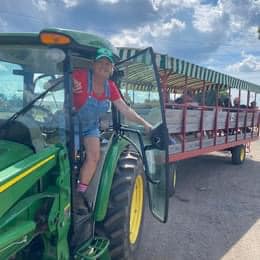
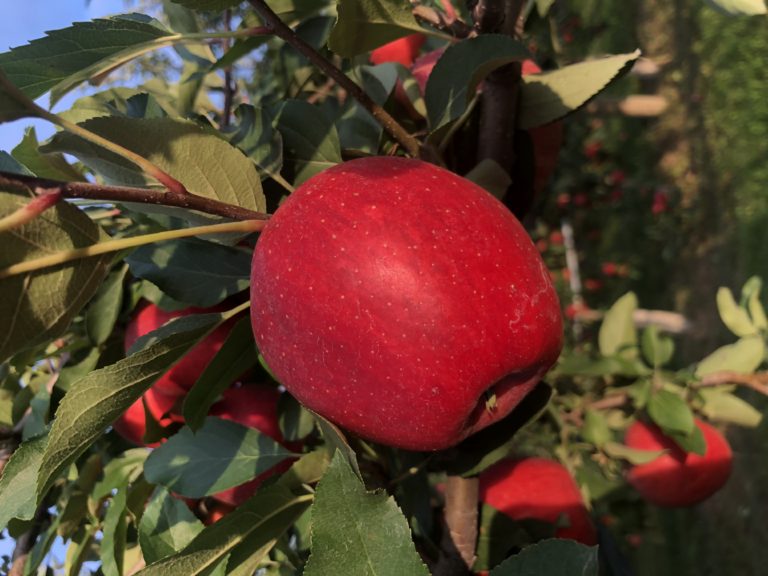
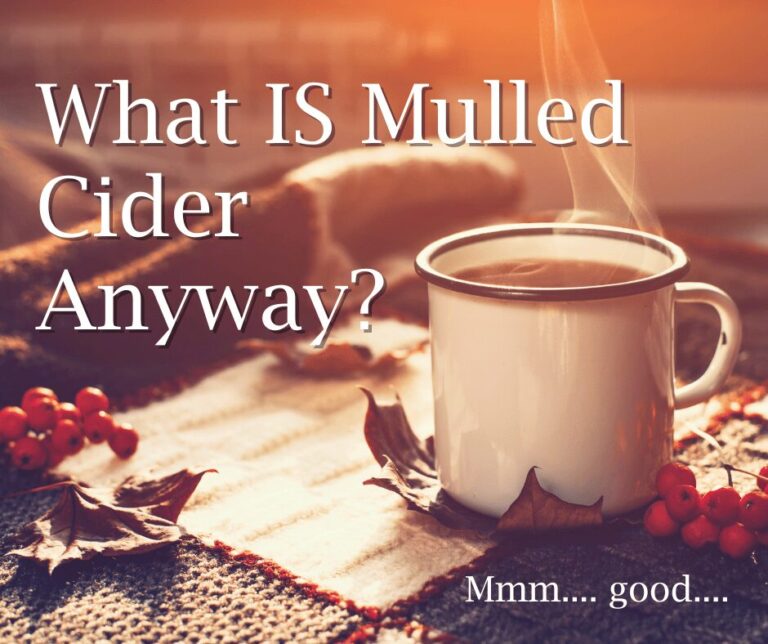

Paula Red
Paula Red: mid to late August. Generally available to pick your own and available farm-picked in our Farm Store. Tart, all-purpose apple; similar to Cortland.
- Ripens: Mid to Late August
- Flavor Profile: 60% Sweet / 40% Tart
- Variety Best For: All Purpose / Baking
- Stores: Well
- Email Me Picking Alerts!

Ginger Gold
Ginger Gold: (Chance Seedling) late August to early September Ginger Golds are an excellent early Golden Delicious type apple, great for eating, salads, and cooking. They are slow to brown when cut and have a sweet slightly spicey ginger flavor. Sweet, dense, tasty; all purpose. Typically available to pick your own and as farm-picked in our Farm Store.
- Ripens: Late August Early September
- Flavor Profile: 70% Sweet / 30% Tart
- Variety Best For: Snacking, Salads, Cooking
- Stores: Well
- Email Me Picking Alerts!

Zestar!™
Zestar!™: (State Fair x MN 1691) late August From the same Minnesota breeding program that introduced Honeycrisp, Zestar!® Apple has a crisp and juicy sweet-tart taste with a hint of brown sugar. Unlike other early season apples that are often soft or mealy, Zestar!® is juicy with a light, crisp texture. A great way to start out the apple picking season!
- Ripens: Late August
- Flavor Profile: 80% Sweet / 20% Tart
- Variety Best For: Eating / Snacking
- Stores: Well

Sansa
Sansa: (Gala x Akane) late August Breed in Japan, an excellent dessert apple resembling Gala.
- Ripens: Late August
- Flavor Profile: 80% Sweet / 20% Tart
- Variety Best For: Dessert Apple / Snacking
- Stores: Well
- Email Me Picking Alerts!

Akane
Akane: (Jonathan x Worcester Permain) late August The UMass Fruit Advisor says about Akane The flavor is mild. It is one of the best pie apples available. When cooked, slices remain intact and unlike many apples, the flavor components of the apple can be detected in the cooked product. Dense, tart; all-purpose apple.
- Ripens: Late August
- Flavor Profile: 80% Sweet / 20% Tart
- Variety Best For: Pies / Snacking
- Stores: Well
- Email Me Picking Alerts!

Gravenstein
Gravenstein: mid to late August Tart, all-purpose apple; green with red stripes.
- Ripens: Mid to Late August
- Flavor Profile: 80% Sweet / 20% Tart
- Variety Best For: All Purpose
- Stores: Well
- Email Me Picking Alerts!
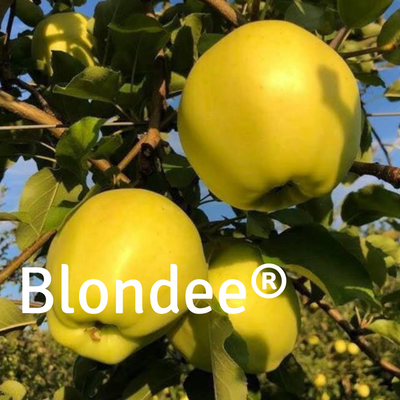
Blondee®
Blondee®: early to mid September Although Blondee looks like a Golden Delicious type apple, it is really more closely related to Gala! Very crisp, sweet and a bit tart, with more flavor than Gala. The flesh does not bruise easily and stores very well!
- Ripens: Early to Mid September
- Flavor Profile: 90% Sweet / 10% Tart
- Variety Best For: All Purpose
- Stores: Well
- Email Me Picking Alerts!
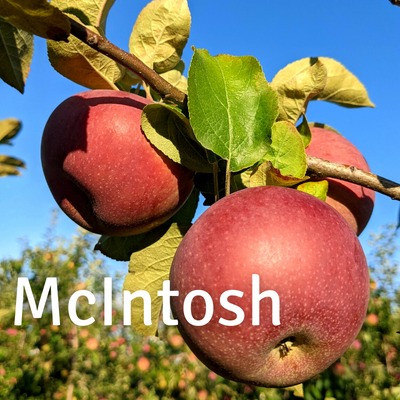
McIntosh
McIntosh: early September to early October Moderately tart, best for fresh eating and sauce; green with red blush. A New England favorite.
- Ripens: Early September to Early October
- Flavor Profile: 60% Sweet / 40% Tart
- Variety Best For: Snacking & Sauce
- Stores: Well
- Email Me Picking Alerts!
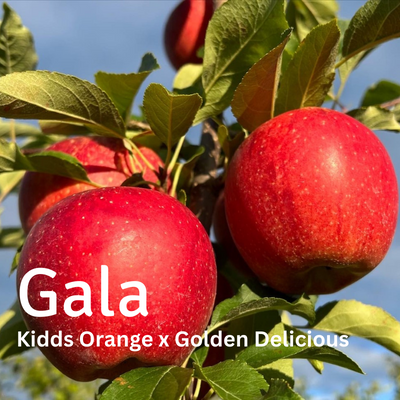
Gala
Gala: (Kidds Orange x Golden Delicious) early September to early October This orange fleshed apple originated from New Zealand and has a unique apple flavor. Very sweet and crisp, many describe its taste as half apple, half pear. An excellent eating apple!
- Ripens: Early September to Early October
- Flavor Profile: 90% Sweet / 10% Tart
- Variety Best For: Snacking
- Stores: Well
- Email Me Picking Alerts!
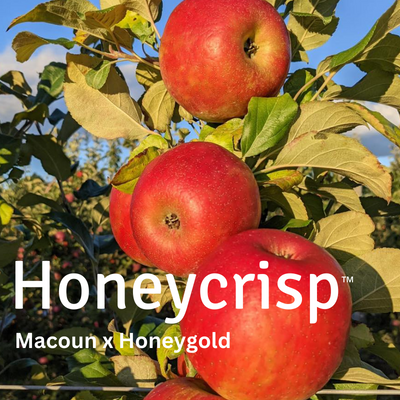
Honeycrisp™
Honeycrisp™: (Macoun x Honeygold) early to late September Often described as explosively juicy and crisp, Honeycrisp have quickly become the most sought after apple on the farm. Remember when picking, for honeycrisp a red apple is a ripe apple. Honeycrisp is a September apple and our most popular, they do not last into October. Get them while you can in September!
- Ripens: September
- Flavor Profile: 90% Sweet / 10% Tart
- Variety Best For: Snacking
- Stores: Well
- Email Me Picking Alerts!
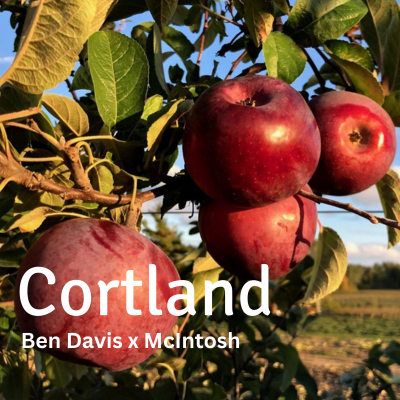
Golden Supreme
Golden Supreme: mid September Early Golden Delicious type apple, with smoother skin and higher flavored than its parent.
- Ripens: Mid September
- Flavor Profile: 90% Sweet / 10% Tart
- Variety Best For: Snacking
- Stores: Well
- Email Me Picking Alerts!

Early Fuji
Early Fuji: mid September to early October Early sports of Fuji that ripen 6 to 8 weeks before its parent.
- Ripens: Mid September - Early October
- Flavor Profile: 90% Sweet / 10% Tart
- Variety Best For: Snacking
- Stores: Well
- Email Me Picking Alerts!

CrimsonCrisp™
CrimsonCrisp™: mid September Attractive crimson red color. Crisp texture and tart complex flavor. Disease resistant variety.
- Ripens: Mid September
- Flavor Profile: 50% Sweet / 50% Tart
- Variety Best For: Snacking
- Stores: Well
- Email Me Picking Alerts!

Cortland
Cortland: (Ben Davis x McIntosh) mid September to mid October Cortland is a great all-purpose apple. One of the largest apples we grow, it has a great sweet tart flavor and a vibrant white flesh that does not brown (great for slicing up for lunch boxes). Cortland stays solid when cooked, making it an ideal apple for making pies and crisps.
- Ripens: Mid September - Mid October
- Flavor Profile: 50% Sweet / 50% Tart
- Variety Best For: Pies, Crisp, Snacking
- Stores: Well
- Email Me Picking Alerts!

Shizuka
Shizuka: mid September Early Mutsu very large yellow-green sweet tart apple.
- Ripens: Mid September
- Flavor Profile: 50% Sweet / 50% Tart
- Variety Best For: Snacking
- Stores: Well
- Email Me Picking Alerts!

Ambrosia
Ambrosia: A chance seeding discovered between a Golden Delicious and Red Delicious Orchard in British Columbia.
- Ripens: Mid September
- Flavor Profile: 50% Sweet / 50% Tart
- Variety Best For: Snacking
- Stores: Well
- Email Me Picking Alerts!

Macoun
Macoun: (McIntosh x Jersey Black) Late September to early October Our customers ask all year for these apples that are only available for a couple of weeks. Macouns are an excellent dessert apple similar to McIntosh but much crispier and great for cooking.
- Ripens: Late September - Early October
- Flavor Profile: 50% Sweet / 50% Tart
- Variety Best For: Snacking, Cooking, Dessert
- Stores: Well
- Email Me Picking Alerts!

Honeygold
Honeygold: (Golden Delicious x Haralson) Similar to Golden Delicious but with a more complex honey flavor. Stores well.
- Ripens: Late September - Early October
- Flavor Profile: 50% Sweet / 50% Tart
- Variety Best For: Snacking
- Stores: Well
- Email Me Picking Alerts!

Liberty
Liberty: (Macoun x Purdue) Similar to macoun, sweet juicy white flesh, deep red on green skin. Disease resitant variety.
- Ripens: Late September - Early October
- Flavor Profile: 50% Sweet / 50% Tart
- Variety Best For: Snacking
- Stores: Well
- Email Me Picking Alerts!
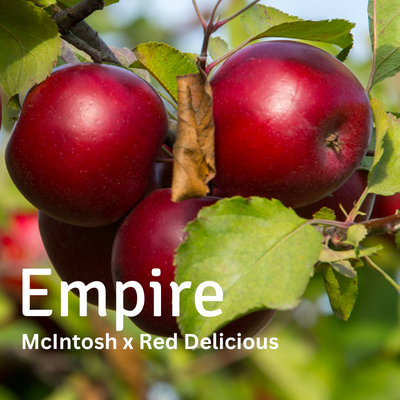
Empire
Empire: (McIntosh x Red Delicious) Empire is the most underrated apple we grow! Empire is a cross of McIntosh and Red Delicious developed at New York States Geneva Agricultural Experiment Station in 1966, and named after the Empire State. Appearing purple on the tree behind a thick coat of natural wax, empire polishes to an attractive bright red and yellow. Empire is a firm apple that is hard to bruise, sweet and very crisp, and its medium size makes empire the perfect apple to send to school with the kids. Stores extremely well and makes a fine apple pie! Great all around apple!
- Ripens: Late September - Early October
- Flavor Profile: 50% Sweet / 50% Tart
- Variety Best For: Snacking, Baking
- Stores: Well
- Email Me Picking Alerts!

Pinova
Pinova: (Clivia x Golden Delicious) Attractive bright red over yellow background. Has strong tropical fruit flavors like Pineapple
- Ripens: Late September - Early October
- Flavor Profile: 50% Sweet / 50% Tart
- Variety Best For: Snacking
- Stores: Well
- Email Me Picking Alerts!
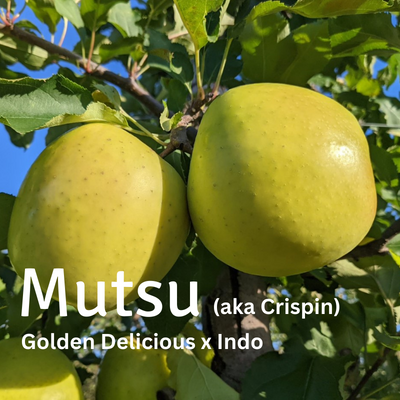
Mutzu
Mutsu: (aka Crispin) (Golden Delicious x Indo) All purpose apple; very large, light green to yellow.
- Ripens: Late September - Early October
- Flavor Profile: 50% Sweet / 50% Tart
- Variety Best For: All Purpose
- Stores: Well
- Email Me Picking Alerts!
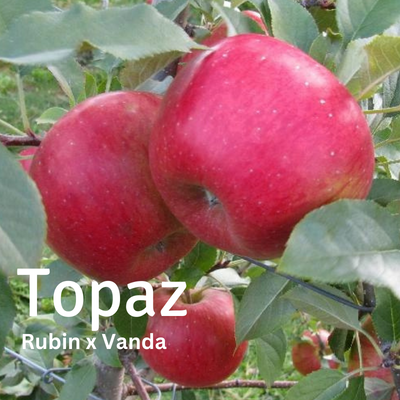
Crimson Topaz
Crimson® Topaz: (Rubin x Vanda) Crimson Topaz or just Topaz is a remarkable squatty apple! It has quickly become the most sought after apple by the staff of the farm. Topaz, bred in the Czech Republic, has a SHARP sweet tart flavor and stores remarkably well. Squat in stature with mostly red over a yellow-orange background, Topaz also has a light texture making it perfect for eating out of hand. I guarantee you wont find Topaz at your local supermarket!
- Ripens: Late September - Early October
- Flavor Profile: 20% Sweet / 80% Tart
- Variety Best For: Snacking
- Stores: Well
- Email Me Picking Alerts!

Hampshire Mac™
Hampshire Mac™: (aka Late McIntosh) (McIntosh Sport) A McIntosh-type apple discovered by Erick Leadbeater of Contoocook, NH, ripening three weeks later than a standard Mac.
- Ripens: October
- Flavor Profile: 20% Sweet / 80% Tart
- Variety Best For: Snacking
- Stores: Well
- Email Me Picking Alerts!
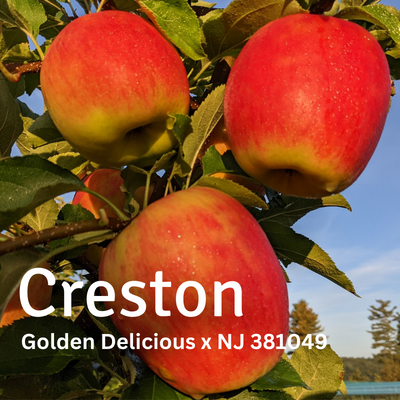
Creston
Creston: (Golden Delicious x NJ 381049) Breed at the Pacific Agri-Food Research Centre Summerland, B.C., Creston is similar to Jonagold but more firm, juicier, and better storage quality. Often described as very similar to Honeycrisp! Large sweet yellow fruit with red blush.
- Ripens: October
- Flavor Profile: 20% Sweet / 80% Tart
- Variety Best For: Snacking
- Stores: Well
- Email Me Picking Alerts!
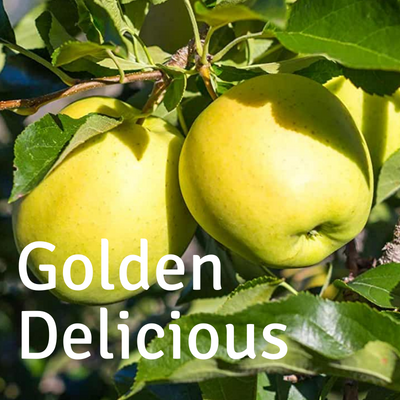
Golden Delicious
Golden Delicious: Sweet, all purpose apple; yellow, sometimes with a red blush.
- Ripens: October
- Flavor Profile: 20% Sweet / 80% Tart
- Variety Best For: Snacking
- Stores: Well
- Email Me Picking Alerts!

Jonagold
Jonagold: (Golden Delicious x Jonathan) Sweet but tart, all purpose apple; red blush over yellow background color.
- Ripens: October
- Flavor Profile: 80% Sweet / 20% Tart
- Variety Best For: All Purpose
- Stores: Well
- Email Me Picking Alerts!

Spencer
Spencer: (McIntosh x Golden Delicious) Pink-red blush on green; large sized apple. Sweet flavor that some say has hint of cinnamon spice.
- Ripens: October
- Flavor Profile: 80% Sweet / 20% Tart
- Variety Best For: All Purpose
- Stores: Well
- Email Me Picking Alerts!
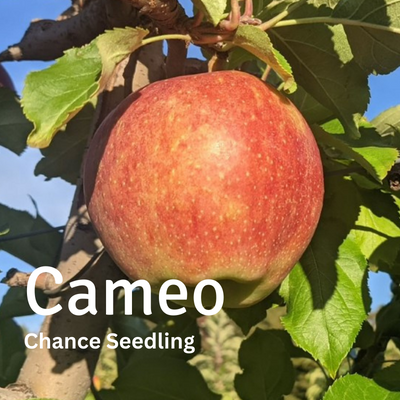
Cameo
Cameo™: (Chance seedling) Firm and crisp with highly appealing sub acid aromatic flavor. Very similar to old-fashoned Red Delicious.
- Ripens: October
- Flavor Profile: 80% Sweet / 20% Tart
- Variety Best For: All Purpose
- Stores: Well
- Email Me Picking Alerts!
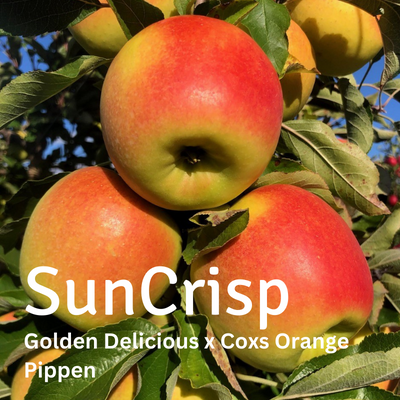
SunCrisp™
SunCrisp™: (Golden Delicious x Coxs Orange Pippen) Sweet idly sub-acid apple, dual purpose apple with yellow flesh and red blush. Stores up to 6 months.
- Ripens: October
- Flavor Profile: 80% Sweet / 20% Tart
- Variety Best For: All Purpose
- Stores: Very Well
- Email Me Picking Alerts!
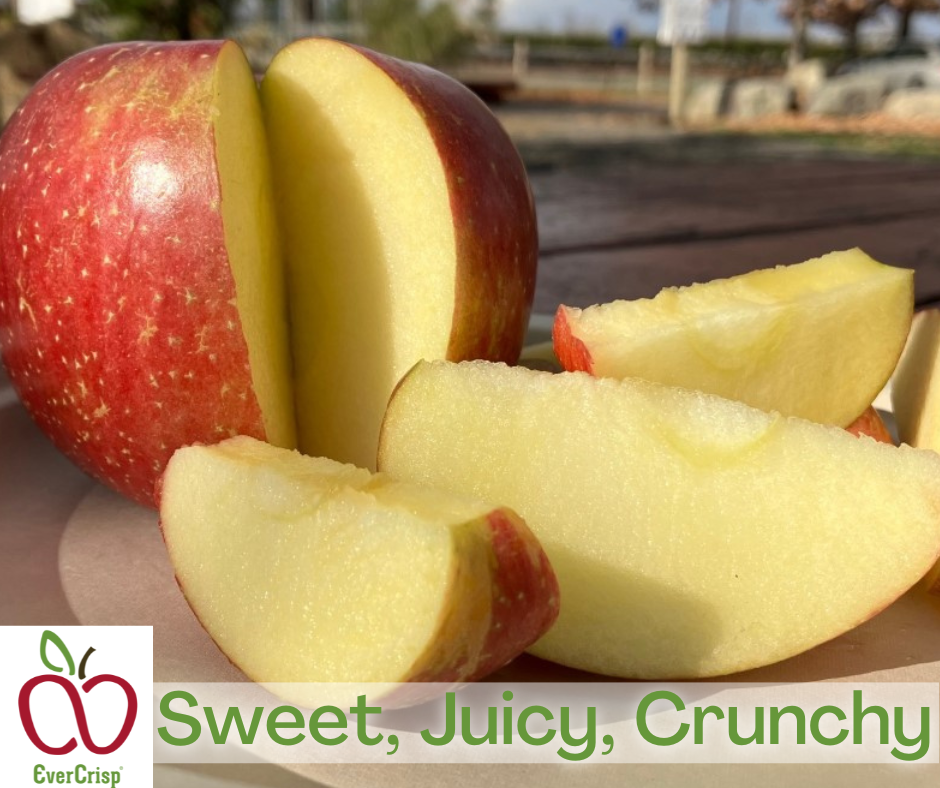
EverCrisp®
EverCrisp®: (Honeycrisp x Fuji) Available 2017 An exciting new variety from the grower association The Midwest Apple Improvement Association, EverCrisp is a sweet firm apple similar to its Fuji parent but also crispy and juicy like Honeycrisp. One of (if not the best) storing apple around. We have kept Evercrisp in regular refrigeration until June and they taste they they are right off the tree!
- Ripens: October
- Flavor Profile: 80% Sweet / 20% Tart
- Variety Best For: All Purpose
- Stores: Very Well
- Email Me Picking Alerts!

Fuji
Fuji: (Ralls Janet x Delicious) Sweet dense apple, stores extremely well.
- Ripens: October
- Flavor Profile: 80% Sweet / 20% Tart
- Variety Best For: All Purpose
- Stores: Very Well
- Email Me Picking Alerts!

Cripps Pink
Bask in the sweet blush of Cripps Pink! Loved by snackers and bakers alike for its unique sweet-tart flavor and firm, crisp flesh, this beauty of an apple is a crowd pleaser. Named for its bright pink skin, this versatile apple is great for eating fresh out of hand as well as in salads, pies, sauces, baking, and freezing. Great for long term storage, flavor improves after a few weeks of cold storage!
- Ripens: October
- Flavor Profile: 80% Sweet / 20% Tart
- Variety Best For: All Purpose
- Stores: Very Well
- Email Me Picking Alerts!

Querina
Querina: Developed at INRA Angers, France, Querina is scab-resistant and moderately resistant to mildew. Parentage includes Golden Delicious and Jonathan, amoung others. The fruit is firm and juicy with a sweet-tart flavor and it develops solid red color. Querina harvests two to three weeks after Golden Delicious and will keep for up to two to three months in regular storage.
- Ripens: October
- Flavor Profile: 80% Sweet / 20% Tart
- Variety Best For: All Purpose
- Stores: Very Well
- Email Me Picking Alerts!

Premier Honeycrisp
The earliest Honeycrisp variety, the Premier Honeycrisp apple has the crispiness and sweetness of later Honeycrisp apples but arrives a few weeks earlier.
- Ripens: Mid - Late August
- Flavor Profile: 80% Sweet / 20% Tart
- Variety Best For: All Purpose
- Stores: Average
- Email Me Picking Alerts!
